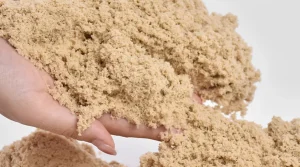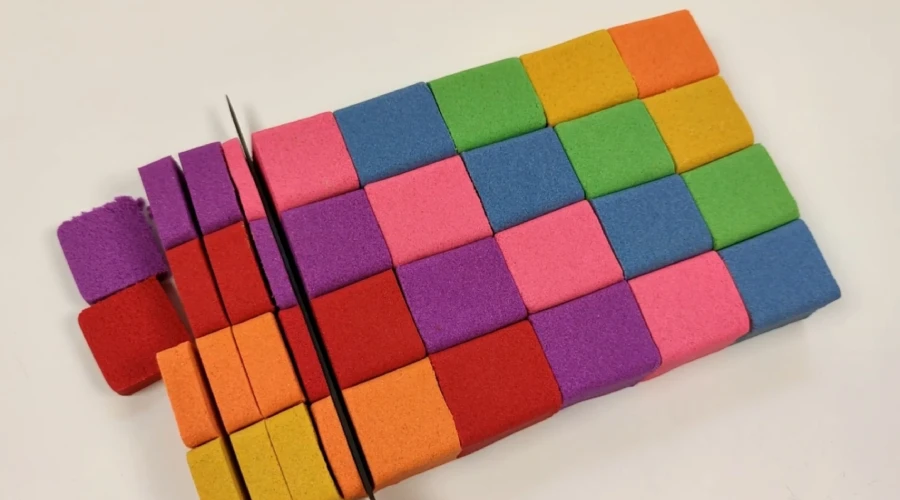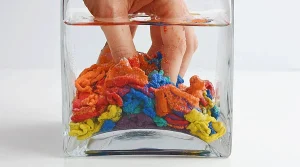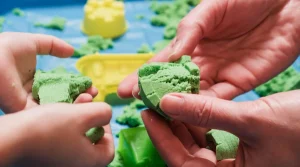
What Is Sensory Sand Made Of? The Science and Benefits
Explore what sensory sand is made of, why children love it, and how its unique materials enhance learning, creativity, and fine motor skills.
#1 Toys Manufacturer in China. WhatsApp: +86 180-0088-4063. Email: [email protected]
#1 Toys Manufacturer in China. WhatsApp: +86 180-0088-4063. Email: [email protected]

Kinetic sand looks like ordinary sand at first glance, yet it behaves in ways that seem almost alive. It flows through your hands, holds its shape, and never fully dries. This strange balance of motion and stillness is what makes scientists and children alike so fascinated by it.
Understanding its composition and structure reveals how a simple grain of sand can become something that feels almost magical.
Kinetic sand is a mixture of natural sand and a small amount of silicone oil. The sand makes up about 98% of the material, while the remaining 2% is a special coating that changes how the grains interact. Each grain is covered with a thin layer of polymer, allowing it to cling to others without becoming sticky to the touch.
When poured, it flows like a thick liquid. When pressed, it holds together like a soft solid. This dual nature gives kinetic sand its “alive” feeling—something between earth and water. It behaves as though invisible strings tie every grain together, forming a flexible network that constantly rearranges itself.
The secret to kinetic sand’s texture lies in polymers—long chains of repeating molecules that create flexibility and cohesion. In this case, the polymer coating binds lightly to the sand’s surface, reducing friction while keeping particles linked. This allows kinetic sand to move as one mass but still separate easily when you touch it.
A child in a science classroom once described it as “liquid Lego dust.” That’s not far off. The polymer acts like a molecular handshake—strong enough to hold, gentle enough to let go. Researchers, such as those from The Journal of Materials Science (2019), note that this coating behaves like a non-Newtonian fluid, giving kinetic sand its smooth, moldable motion.
Regular sand is dry and loose; each grain moves freely without connection. That’s why beach sand scatters with the wind and slips through fingers. Kinetic sand, on the other hand, sticks to itself but not to skin or surfaces. Its internal bonding lets it form stable shapes, like a miniature dune that doesn’t collapse.
Imagine building a sandcastle indoors without water. Regular sand would crumble instantly, but kinetic sand keeps its form. This is because the polymer film around each particle traps a thin layer of air, helping grains slide yet stay united. In laboratory tests, this balance of cohesion and friction control gives kinetic sand its unmistakable flow—calm, steady, and oddly satisfying to watch.
There’s something almost hypnotic about the way kinetic sand moves. It slips and slides like a thick liquid, yet it holds its shape when pressed.
Scientists describe this strange motion as a balance between cohesion and flow. While it may look simple, its behavior is the result of fascinating physics that connects surface tension, friction, and polymer science in a single, soft handful.
Every grain of kinetic sand is coated with a thin polymer film that gives it both grip and glide. This coating changes how the grains interact with each other, creating just enough friction for them to cling together without clumping into a solid mass. The result is a material that flows slowly, like honey, but can still be sculpted into precise shapes.
Scientists sometimes call this property “controlled cohesion.” In a 2018 study by the American Journal of Physics, researchers compared the motion of kinetic sand to that of damp granular materials, such as wet beach sand, but found its behavior more consistent. Unlike water, which evaporates and weakens the bonds, the polymer ensures the grains remain connected even after long use.
One of the biggest surprises about kinetic sand is that it doesn’t dry up. This is because it doesn’t rely on moisture to hold its shape. The polymer coating acts as a permanent binder, trapping tiny layers of air that prevent evaporation or hardening. In essence, kinetic sand maintains its texture because there’s no water to lose.
If you leave it on a table for weeks, you’ll notice it stays soft and moldable. That’s the beauty of its chemistry—it resists environmental changes. The silicone oil component also helps it repel water and dust, keeping it stable even in dry climates. This makes it behave like a living material, always ready to flow when touched.
Kinetic sand blurs the line between solid and liquid. When you press it, it resists pressure like a solid. When you let it fall, it flows like a liquid. This behavior is what scientists call “viscoelasticity,” a property shared by materials such as slime and silly putty. It responds differently depending on how much force you apply.
Think of it like a landscape in motion—stable but alive. The grains rearrange themselves under gravity, but when shaped, they lock together through frictional bonds. It’s a miniature model of how planetary surfaces might behave under extreme conditions, a kind of alien terrain in your hands. Perhaps that’s why even adults find themselves mesmerized, studying its slow, steady dance as if it held the secrets of another world.
Beyond its science, kinetic sand captures the senses in quiet and surprising ways. Its soft movement, silky texture, and muted sounds create a calming rhythm that draws people in. Whether molded, squeezed, or allowed to flow freely, it offers a sensory experience unlike any other toy or material.
Touch is the first sense that connects us to the world, and kinetic sand turns that connection into play. Each grain moves smoothly under pressure, slipping apart and reforming with ease. The texture is neither sticky nor dusty—it’s just soft enough to mold and just firm enough to resist slightly, creating a pleasing feedback loop for the fingers.
Psychologists suggest that this tactile balance triggers a mild release of dopamine, the same response that comes from rhythmic movements like kneading dough or sifting flour. In classrooms, teachers notice how children become focused and calm while handling kinetic sand, as if the motion itself guides their concentration. It’s science disguised as play.
Kinetic sand isn’t always beige. It comes in bright blues, pinks, purples, and natural tones that all influence how the brain reacts. Studies in Frontiers in Psychology (2020) found that color affects both emotional response and sensory attention—warmer tones may spark creativity, while cooler ones tend to calm the mind.
The texture also adds another layer of sensory engagement. The fine granules produce a faint, whispering sound as they move, almost like soft rainfall. This multi-sensory experience—touch, sight, and sound—stimulates the brain’s sensory integration pathways. It’s not just about feeling something pleasant; it’s about how all senses quietly synchronize during play.
There’s a quiet rhythm to working with kinetic sand. It shifts and settles slowly, mirroring the steady pace of breathing. For children, this rhythm provides comfort during unstructured play. For adults, it offers a simple escape from the noise of digital life.
Occupational therapists often use kinetic sand to help regulate sensory input. The repetitive motion of squeezing, molding, and reshaping engages both fine motor control and emotional grounding. In one therapy session, a child once described it best: “It feels like the sand listens to me.” That gentle, almost living quality may be the secret to its universal calm—a texture that doesn’t just move in your hands, but moves with you.
Kinetic sand isn’t just fun—it’s quietly educational. When children shape, press, and cut it, they’re not only building castles but also developing essential skills. The material’s unique texture encourages patience, problem-solving, and experimentation. Through these playful interactions, learning becomes natural, and discovery happens in small, joyful moments.
Every squeeze, roll, or scoop of kinetic sand helps train the small muscles in a child’s hands. These fine motor skills are the foundation for writing, cutting, and other daily tasks. The resistance and flow of the sand provide just the right amount of feedback, allowing children to control movement with precision.
In occupational therapy, kinetic sand is often used to strengthen coordination. It reacts predictably to pressure, so kids can practice gripping and releasing without frustration. One teacher once described it as “training clay for the hands.” Through repetition, children learn balance and rhythm, turning play into a physical learning exercise.
Kinetic sand’s open-ended nature lets children explore without boundaries. There are no right or wrong results—only endless possibilities. A handful of sand might become a tiny planet, a dessert shop, or a secret landscape. This kind of free play encourages imagination and flexible thinking.
Psychologists note that tactile creativity helps children express ideas they can’t yet describe with words. When sculpting or storytelling with sand, they translate inner thoughts into form and motion. Even adults rediscover this creative spark, enjoying the feeling of shaping something that holds its shape just long enough to change again.
The steady motion of handling kinetic sand promotes concentration. It slows down thinking in a way that supports mindfulness, allowing the brain to focus on one task at a time. Teachers often use it during quiet classroom activities, noticing that students become calmer and more attentive while working with it.
From a cognitive perspective, kinetic sand stimulates both hemispheres of the brain. The tactile interaction engages sensory processing, while planning and sculpting activate spatial reasoning. This dual engagement improves focus and persistence—important traits for problem-solving and learning. Like a small meditation, it turns simple play into quiet mental training.
>> What Are the Benefits of Kinetic Sand Toys?
Kinetic sand stands out among sensory materials, but understanding its uniqueness means comparing it to others—playdough, slime, and air dry clay. Each of these substances offers different tactile experiences and learning opportunities.
At first glance, kinetic sand and playdough seem similar. Both can be molded, squished, and shaped into endless creations. However, their composition sets them apart.
Playdough is water-based and soft, which makes it easy to blend colors and roll flat. Kinetic sand, in contrast, flows under gravity yet holds firm when pressed. It doesn’t dry out or crumble because it relies on polymer-coated grains rather than moisture.
Children often notice this difference immediately. While playdough feels warm and sticky, kinetic sand feels cool and silky. In a classroom test, a teacher once observed that playdough encourages sculpting and detailed work, while kinetic sand inspires more fluid, experimental designs. Both are creative, but one feels like earth, and the other, like a soft wave.
Slime and kinetic sand both share a certain mesmerizing quality—they stretch, flow, and reform endlessly. But scientifically, they belong to different worlds. Slime is a liquid polymer, made through chemical cross-linking that gives it elasticity. Kinetic sand, on the other hand, is a granular solid with coated particles that imitate liquid movement.
When touched, slime stretches and drips, creating an unpredictable play experience. Kinetic sand moves in a slower, more controlled way—it breaks cleanly and rebuilds easily. Parents often prefer it because it leaves less residue, while researchers note that its “granular fluid” behavior provides a more consistent sensory pattern for studying touch-based responses.
Air dry clay sits at the opposite end of the sensory spectrum. It’s firm, dense, and designed to harden over time, making it ideal for long-lasting crafts. Kinetic sand, by contrast, never hardens—it remains soft, reusable, and alive in motion. One material captures permanence; the other celebrates change.
For educational play, air dry clay strengthens hand control and planning because children must shape quickly before it sets. Kinetic sand allows more improvisation, encouraging trial and error without consequence.
Both materials, in their own ways, teach patience and persistence. Yet kinetic sand, with its quiet shifting and forgiving texture, invites exploration over perfection—a lesson as valuable as any sculpture it helps create.
Safety and sustainability are important when studying materials children interact with daily. Kinetic sand offers an interesting case—its chemistry balances safety, durability, and environmental awareness. Though designed mainly for play, it also reflects thoughtful material science, where non-toxic ingredients and long-lasting properties work together for safer sensory experiences.
Kinetic sand is made primarily of natural quartz sand mixed with a small amount of silicone oil. Both components are considered safe for regular handling and meet most international toy safety standards, such as ASTM and EN71. Unlike traditional clay or dough, it contains no gluten, water, or harsh chemicals.
Because the polymer coating stays bound to the sand grains, there’s no residue left on skin or surfaces. Parents often notice that it doesn’t stain clothing or stick to furniture. Its chemical stability also means it won’t give off fumes or break down into harmful particles, making it suitable for children of many ages. However, as with all toys, adult supervision helps ensure that small children don’t try to taste or ingest it.
From an environmental standpoint, kinetic sand is relatively low impact but not entirely biodegradable. The natural sand portion can return to the environment safely, yet the silicone component—derived from synthetic polymers—takes much longer to decompose. This means discarded kinetic sand shouldn’t be mixed with soil or washed down drains.
Many manufacturers now research eco-friendlier alternatives, such as bio-based polymers, to reduce long-term waste.
According to Environmental Science & Technology (2021), similar materials are being re-engineered to maintain performance while minimizing microplastic release. These advances could make future sensory toys both sustainable and safe without changing their satisfying texture.
>> Can Kinetic Sand Go Down the Sink? What You Needs to Know!
Kinetic sand lasts for years if cared for properly. It should be stored in an airtight container or resealable bag to prevent dust buildup. Since it doesn’t dry out, moisture control isn’t a major issue, but keeping it clean ensures its smooth texture remains intact.
If small debris or lint mixes in, gently pressing the sand through a mesh sieve or removing particles by hand usually restores its purity. It’s best used on clean surfaces or play mats to prevent contamination.
Teachers who use it in classrooms often rotate batches to maintain hygiene and encourage responsible handling. With a bit of care, kinetic sand remains safe, clean, and endlessly reusable—proof that good science can also make good play.
Beyond the classroom or playroom, kinetic sand holds a quiet place in therapy and emotional care. Its texture and movement encourage mindfulness, calmness, and focus.
Psychologists and occupational therapists use it as a gentle bridge between physical touch and emotional balance. What seems like simple play can, in fact, become a moment of stillness—a tactile meditation that helps both children and adults reconnect with themselves.
Adults often rediscover kinetic sand as a stress-relieving tool. The slow, rhythmic motion of shaping and sifting helps quiet mental noise. Each handful flows predictably, responding only to touch and gravity. This predictability provides comfort in a world full of uncertainty.
Therapists describe it as “grounding through texture.” Studies in Frontiers in Psychology (2022) found that tactile play can reduce cortisol levels and promote mindfulness, similar to breathing exercises. Some adults keep a small tray of kinetic sand on their desk, using it during long workdays to refocus attention. The act of pressing, slicing, and watching it fall becomes a simple, wordless form of relaxation.
Occupational therapists often include kinetic sand in sessions for children and patients recovering from injury. Its soft resistance helps rebuild hand strength, coordination, and sensory awareness. Because it’s forgiving, it allows repetitive motion without strain, making it ideal for gradual motor recovery.
For children with sensory processing challenges, kinetic sand provides a safe and controllable experience. The grainy-yet-smooth texture offers tactile feedback that helps regulate sensory input. In therapy journals, clinicians describe it as a “transitional material”—one that invites exploration while maintaining a sense of security. It’s a rare blend of science and comfort in one simple substance.
Touch plays a crucial role in emotional stability. When we manipulate kinetic sand, our hands send signals to the brain that trigger calm, focus, and presence. The repetitive action of molding and reshaping helps organize sensory information, creating a physical rhythm that mirrors emotional rhythm.
Children who struggle with anxiety or overstimulation often respond positively to kinetic sand. Therapists use it as a nonverbal communication tool—emotions take shape in the sand when words are too hard to find. In this way, it becomes more than a toy or a tool; it becomes a medium for expression. Like waves reshaping a shore, every press and release helps the mind settle into balance once again.
Kinetic sand may look simple, but its behavior changes subtly under different environmental conditions. Temperature, humidity, and air quality can all affect how it feels and moves. Observing these changes offers a glimpse into the physics of granular materials—a field where science and sensory play meet. Even small shifts in climate can make this “living sand” behave in surprisingly different ways.
Kinetic sand reacts to temperature changes much like a living organism might. In warmer environments, the silicone coating becomes slightly more flexible, allowing the sand to flow faster and feel smoother. When it’s cold, the same coating stiffens, causing the sand to hold its shape longer. These shifts are small but noticeable, especially during hands-on play.
Humidity plays an equally important role. Although kinetic sand doesn’t rely on water, moisture in the air can make it heavier and clumpier. In dry climates, it feels lighter and more powdery. Researchers studying its behavior under controlled humidity found that polymers subtly absorb air moisture, altering surface tension and flow. It’s a quiet reminder that even a “dry” material is never fully isolated from its environment.
One of kinetic sand’s most intriguing features is its ability to cling to itself but not to skin. This happens because the grains are coated in silicone oil, which lowers surface friction. When the grains touch each other, they form weak cohesive bonds; when they touch your hands, those bonds don’t form at all. That’s why it gathers neatly into piles without leaving residue.
Imagine tiny magnetic spheres that attract only their own kind—that’s how kinetic sand behaves. The polymer surface creates microscopic bridges between grains while repelling other materials. This controlled cohesion gives it that smooth, self-contained motion. It’s neat, clean, and oddly satisfying, behaving as if it knows exactly where it belongs.
Kinetic sand is surprisingly durable. Unlike clay or dough, it doesn’t dry out or harden because it contains no evaporating ingredients. The silicone oil keeps the sand grains coated indefinitely, preserving the same texture even after years of use. Over time, however, dust or lint may change how it feels.
To maintain its texture, gentle care is all that’s needed. Storing it in an airtight container keeps debris out and prevents it from picking up humidity. If it starts to feel clumpy, a few turns between the fingers usually restore its flow. In a sense, the sand “heals” itself—the polymer network constantly realigns, returning to its natural state. That quiet resilience is part of what makes kinetic sand feel, in a small and curious way, alive.
Kinetic sand has already transformed play and therapy, but its story isn’t finished. Advances in material science, combined with a growing understanding of sensory learning, suggest new directions for this fascinating medium. The future may bring smarter, safer, and more interactive forms of kinetic sand, expanding its role from a toy to a tool for exploration and learning.
Researchers continue to experiment with alternative polymers and coatings to make kinetic sand more eco-friendly and durable. Bio-based silicones and recycled materials are being tested to maintain the same smooth texture while reducing environmental impact.
These innovations could lead to kinetic sand that is even more versatile—adapting to temperature, pressure, or even light conditions. According to Materials Today (2023), granular materials like kinetic sand are inspiring new studies in soft robotics and adaptive surfaces, showing how a simple sensory toy can inform advanced engineering concepts.
Sensory play is increasingly recognized as a vital component of early childhood education. Teachers use tactile materials to teach spatial reasoning, coordination, and problem-solving skills. Kinetic sand fits naturally into this approach, offering a controlled, safe medium for exploration.
Research in Early Childhood Research Quarterly (2021) indicates that children engaged with kinetic sand show improved focus and collaboration during group activities. It’s not just about play—it’s a subtle tool for cognitive development and social learning, providing hands-on experiences that textbooks alone cannot offer.
>> The Amazing Science of Kinetic Sand: 7 Fascinating Facts
Kinetic sand is inspiring a wave of new sensory-based tools. Innovations include modular playsets, multi-textured sand blends, and interactive environments that combine light, sound, and motion. Educators and therapists are exploring these tools for enhanced engagement, fine motor training, and even stress reduction.
Future trends point toward hybrid materials that merge kinetic sand with augmented reality or tactile sensors. These developments could transform the way children—and adults—interact with sensory materials, blending play, learning, and scientific curiosity in ways that are still unfolding. Kinetic sand may remain a simple handful of grains, but its potential to teach and inspire is growing every day.
Kinetic sand remains a unique blend of science, texture, and sensory appeal. Its flow, cohesion, and resilience make it both a tool for learning and a medium for relaxation. From tactile exploration to cognitive engagement, kinetic sand continues to fascinate, offering endless opportunities for discovery and play.
Kinetic sand is not designed to mix with water. Adding water can break down the polymer coating, causing it to lose its flow and stickiness. While a few drops may slightly change its texture, prolonged contact with water can ruin its unique properties.
Yes, kinetic sand is generally safe for children with sensory sensitivities. Its soft, moldable texture provides predictable tactile feedback without sharp edges or sticky residues. However, supervision is recommended for very young children or those prone to putting objects in their mouths.
Kinetic sand is denser than natural sand due to the polymer coating around each grain. This coating increases cohesion and weight slightly, giving it a solid feel while maintaining a flowing motion that natural sand cannot achieve.
With proper care, kinetic sand can be reused for years. Storing it in airtight containers and keeping it clean from debris preserves its texture. Minor lint or dust can be removed by hand, and the polymer network naturally realigns, maintaining flow and moldability.
Yes, kinetic sand supports lessons in physics, geometry, and problem-solving. Its granular flow demonstrates basic principles of friction, cohesion, and non-Newtonian behavior, allowing students to explore science concepts hands-on while engaging in tactile experimentation.
More Related...

Explore what sensory sand is made of, why children love it, and how its unique materials enhance learning, creativity, and fine motor skills.

Is magic sand safe for kids? Explore safety facts, age guidelines, and expert advice to ensure fun, creative, and secure sensory play.

Kinetic sand toys offer fun and education in one—find out how they support child development, relaxation, and imaginative play.

Curious about magic sand? Explore how it repels water, what it’s made of, and why it’s a hit in science classrooms and homes.

Our team will answer your inquiries within 48 hours.
Copyright © 2025 GuangDong AKIA Technology Co,. Ltd. All Rights Reserved